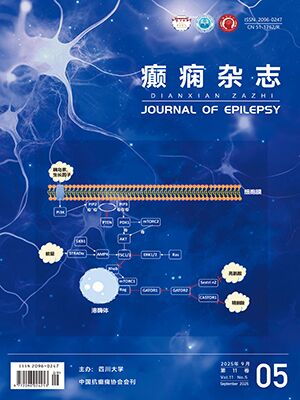| 1. |
廖卫平, 何娜.癫痫基因检测的临床应用及其展望.中华神经科杂志, 2011, 44(17):659-662.
|
| 2. |
Escayg A, Helse A, Meisler MH, et al. A novel SCN1A mutation associated with generalized epilepsy with febrile seizures plus and prevalence of variants in patients with epilepsy. Am J Hum Genet, 2001, 68(4):866-873.
|
| 3. |
Claes LRF, Deprez L, Suls A, et al. The SCN1A variant database: a novel research and diagnostic tool. Hum Mutat, 2009, 30(2):e904-e920.
|
| 4. |
Goldin AL, Barchi RL, Caldwell JH, et al. Nomenclature of voltage-gated sodium channels. Neuron, 2000, 28(10):365-368.
|
| 5. |
Goldin AL. Evolution of voltage-gated Na+ channels. J Exp Biol, 2002, 205(21):575-584.
|
| 6. |
Catterall WA, Kalume F, Oakley JC. NaV1.1 channels and epilepsy. J Physiol, 2010, 588(132):1849-1859.
|
| 7. |
Meng H, Xu HQ, Yu L, et al. The SCN1A mutation database:updating information and analysis of the relationships among genotype, functional alteration, and phenotype. Hum Mutat, 2015, 36(6):573-580.
|
| 8. |
Scheffer IE, Berkovic SF. Generalized epilepsy with febrile seizures plus:a genetic disorder with heterogeneous clinical phenotypes. Brain, 1997, 120 (pt 3):479-490.
|
| 9. |
Escayg A, MacDonald BT, Meisler MH, et al. Mutations of SCN1A, encoding a neuronal sodium channel, in two families with GEFS+2. Nat Genet, 2000, 24(11):343-345.
|
| 10. |
Claes L, Del-Favero J, Ceulemans B, et al. De novo mutations in the sodium-channel gene SCN1A cause severe myoclonic epilepsy of infancy. J Hum Genet (Am), 2001, 68(7):1327-1332.
|
| 11. |
Ohmori I, Ouchida M, Ohtsuka Y, et al. Significant correlation of the SCN1A mutations and severe myoclonic epilepsy in infancy. Biochem Biophys Res Commun, 2002, 295(112):17-23.
|
| 12. |
Liao WP, Shi YW CL, Deng WY, et al. Partial epilepsy with febrile seizure plus (PEFS+) and novel SCN1A mutations. Epilepsia, 2007, 48(20):130.
|
| 13. |
Liao WP, Shi YW, Long YS, et al. Partial epilepsy with antecedent febrile seizures and seizure aggravation by antiepileptic drugs:associated with loss of function of Na1.1. Epilepsia, 2010, 51(23):1669-1678.
|
| 14. |
Kumakura A, Ito M, Hata D, et al. Novel de novo splice-site mutation of SCN1A in a patient with partial epilepsy with febrile seizures plus. Brain Dev, 2009, 31(10):179-182.
|
| 15. |
Grantham R. Amino acid difference formula to help explain protein evolution. Science, 1974, 185(12):862-864.
|
| 16. |
Heng Meng, Bin Tang, Yong-Hong Yi, et al. Splice-site Mutations in SCN1A cause epilepsies with febrile seizures:mechanisms and correlations with clinical severity. Epilepsia, 2013, 54(Suppl 3):192.
|
| 17. |
Catterall WA. From ionic currents to molecular mechanisms:the structure and function of voltage-gated sodium channels. Neuron, 2000, 26(10):13-25.
|




